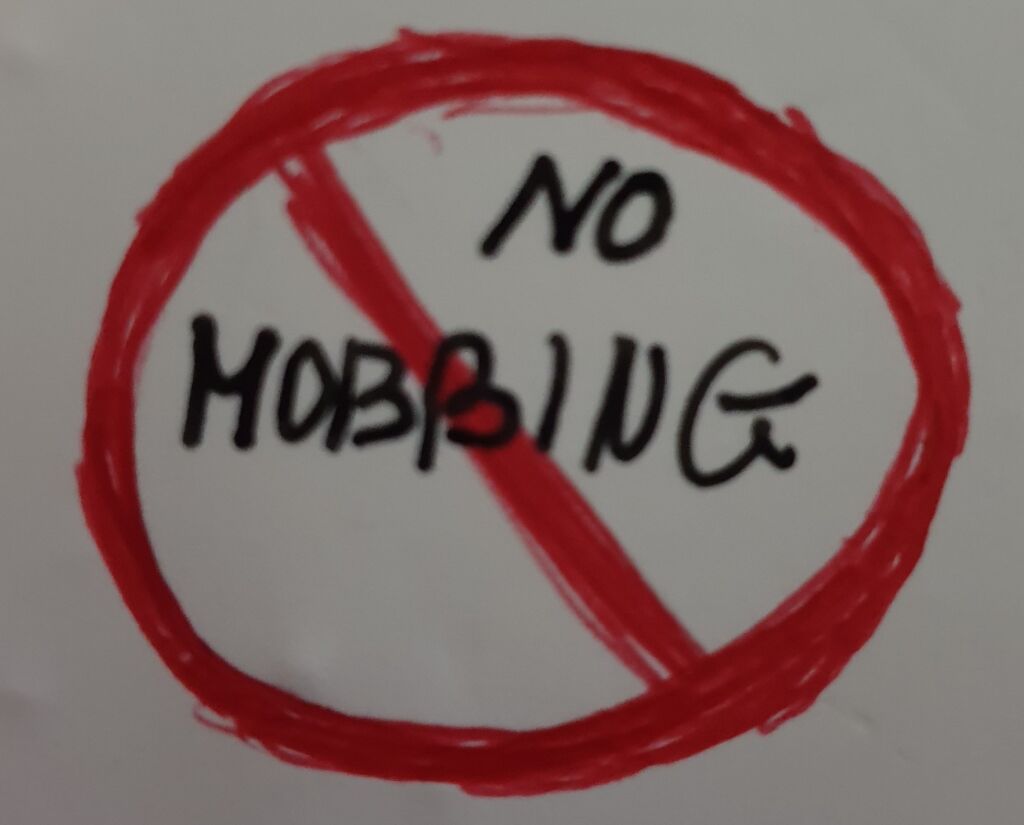What is bullying?
Some clarification is needed because not all conflicts can be traced back to this phenomenon. Furthermore, in order to be able to reconnect, certain circumstances must occur linked to the systematic nature of the conduct and its duration over time.
Arguing with the boss or experiencing moments of great stress can happen to everyone but undergoing aggressive practices and behavioral strategies aimed at psychological, social and professional destruction that cause psychological problems that often precede the dismissal is another thing entirely.
The protagonists of mobbing are: i mobbers, those who adopt vexatious behaviors; the victims or mobbed, those who suffer; bystanders, those who are not directly involved in the vexatious behavior but whose behavior can influence the development of mobbing.
Their silence is due to fear of retaliation or even losing their jobs.
Harald Ege, doctor specialized in Work and Organizational Psychology, known in Italy for having been the first, in 1995, to propose the term "mobbing" gave this definition of the phenomenon: that "form of psychological terror in the workplace, exercised through repeated aggressive and harassing behavior by colleagues or superiors. The victim of these real persecutions sees himself marginalized, slandered, criticized: he is entrusted with disqualifying tasks or is moved from one office to another, or is systematically ridiculed in front of clients or superiors. In the most serious cases, there is even sabotage of work and illegal actions. The purpose of such behaviors can be varied, but always destructive: eliminating a person who has become "uncomfortable" in some way, inducing him to voluntarily resign or causing his motivated dismissal".
Basically it is a form of psychological terror exercised with aggressive and repeated conduct aimed at preventing the victim from working or otherwise carrying out his or her business serenely.
Notwithstanding the article 2087 of the Civil Code obliges the employer to guarantee a safe working environment, supervising any potentially harmful conduct towards workers by colleagues or superiors, certain behaviors continue to occur.
By whom is it committed?
It is usually committed by superiors against employees.
In Italy it is very common among white-collar workers.
In the public sector more than in the private sector: especially schools, health and public administration.
In the public sector it seems to be perpetrated by colleagues and superiors in order to induce those who have set themselves in contrast with the ideology of the majority of the office to desist from its action.
In the private sector, bossing (boss against the subordinate) is widespread.
In any case, on the basis of the subjects who carry out the mobbing and the characteristics of the mobbing conduct, the jurisprudence has developed some categories:
1) vertical bullying, itself distinguished in mobbing descending and ascending.
In the first case the persecutory conduct can be committed by the employer or in any case a hierarchical superior of the employee, while in the ascendant mobbing it is a lower-level worker who attacks a person superior to him who occupies a higher position or level
2) horizontal bullying in the event that the mobbing behavior is carried out by one or more colleagues placed at the same level as the victim.
The reasons they can be the most diverse: competition, the intention of pouring internal problems of various kinds onto a scapegoat, strictly personal motivations, such as dislike, or the consequences of the victim's refusal of the advances of the superior or colleague later became a mobber. Finally, large companies often use it to circumvent the legislation protecting dismissals, causing the "unwelcome" worker to suffer a condition of psychophysical stress suitable for determining him to leave the workplace of his "spontaneous will".
Contrary to what one might think, bullying does not only occur against weak employees, but above all against workers with a strong personality, or very good ones, or with seniority that has become too expensive in terms of wages.
What are vexatious behaviors?
We can say that bullying is not made up of a single fact but of a series of conducts which are also different from each other but which can be framed in a single scheme.
I will indicate a few but the list is exemplary and not exhaustive:
– physically isolate the worker (e.g. depriving him of equipment such as a computer, printer, telephone, excluding him from refresher courses or meetings);
– damage its reputation by ridiculing and/or spreading gossip;
– assign him disqualifying, degrading or humiliating tasks;
– assign him excessive workloads;
– place it in unsuitable workstations;
– check it continuously;
– revoke or not grant him holidays or permits
– sexually harass him etc.
The affected person has devastating effects. The damages can be of a physical and mental nature.
But the consequences of this phenomenon do not only involve the victim.
The lack of serenity in the workplace and the health problems of the mobbed cause a lower performance and, therefore, an economic loss for the company.
Moreover, the competition can take advantage of the negative publicity that the company will inevitably receive.
And obviously the resulting stress also involves the victim's family members because he will vent anger, depression and dissatisfaction in the family and this serious malaise will cause an imbalance in relationships.
Compensation for damage
The victims will be able to sue their perpetrators in order to obtain compensation for the suffering suffered. Think of the mobbed victim who is harassed and humiliated daily by his superiors who contracts a form of depression.
The damage that the victim of mobbing may suffer therefore consists of:
– biological damage, ie the damage to the psycho-physical integrity of the person. The systematic nature of the conduct implemented towards the mobbed person gives him a real psycho-physical disability, that is, a permanent reduction in working capacity. Therefore, bullying is framed within the category of professional diseases which give the right to the recognition of biological damage, as admitted by theNational Institute of Occupational Accident Insurance (Inail).
– non-pecuniary damage, i.e. the damage to the life of relationships, to the emotional sphere, etc.;
– property damage, i.e. the financial consequences of bullying such as, for example, the money spent on medical and psychological care, etc.
The quantification of pecuniary damage is simpler because it will suffice to attach, for example, the invoices for medical expenses incurred, while for non-pecuniary damage, the tables prepared by the Court of Milan will be used throughout the country.
To support a valid compensation action in court, there are essentially two prerequisites:
1) the objective element, supplemented by a plurality of specific behaviors of the employer;
2) the subjective element, i.e. the persecutory intent of the employer.
Fundamental proof to be provided is that relating to the damages that can be given through witnesses, expert reports and medical certificates that certify the state of health of the employee and above all that these damages are due to the harassing acts suffered.
The proof of these last aspects is of great importance for the Judges.
It must be emphasized that the burden of proof rests on the employee.
In essence, it is the victim who has to prove the mobber's intent.
The persecutory intent that unifies the individual mobbing acts in support of the employer's conduct must be demonstrated. You must prove that you are ill.
Possible symptoms may include breathing difficulties, skin problems and dermatitis, depression, gastritis, difficulty concentrating, palpitations, nervous breakdown, insomnia, anxiety, panic attacks, etc.
All these problems that affect mood and family and social relationships can affect the desire to continue living, leading, in the most serious cases, even to suicide.
Once the Judge detects the presence of vexatious actions and the existence of damage to health, he appoints a medical consultant who will have to verify that the aforementioned diseases depend on the attacks suffered and that, therefore, there is a causal link.
Criminal protection
When the persecutory conduct integrates the details of a crime, the worker also has criminal protection available.
However, the specific crime of mobbing does not exist in current legislation. In any case, considering the variety of forms that persecutory behaviors can take from time to time, jurisprudence has recognized the integration of different criminal cases.
Particularly:
– Ill-treatment against family members and cohabitants (Article 572 of the Criminal Code)
– private violence (art. 610 criminal code)
– threat (art. 612 criminal code)
– willful negligent bodily harm (respectively articles 582 and 590 of the criminal code)
– sexual violence (art. 609 bis criminal code) – harassment or disturbance of people (art. 660 criminal code)
– abuse of office (art. 323 criminal code)
– extortion (art. 629 criminal code)
– stalking (art. 612 bis criminal code).
I will tell you more about mobbing in the criminal sphere in a video that I will publish on my YouTube channel, relating to my recent speech at a webinar on the subject.
As mentioned, not all conflicts can be traced back to this phenomenon.
There is no mobbing if the results of the case, punctually analysed, reveal a situation of conflict between the appellant and the defendant but not so serious as to lead the conduct to a persecutory intent. It is not bullying if there is a picture of ordinary conflict that can be connected to the typical dynamics of the work environment.
What evidence is needed to prove that you are a victim of bullying?
For the Cassation, the substantial and procedural elements necessary to configure a conduct of mobbing are:
1) a series of behaviors of a persecutory nature – unlawful or even lawful if considered individually – which, with vexatious intent, are carried out against the victim in a specifically systematic and prolonged way over time, directly by the employer or one of his representatives or even by other employees subject to the executive power of the former”;
2) the event harmful to the health, personality or dignity of the employee;
3) the aetiological link between the described conducts and the damage suffered by the victim in his own psychophysical integrity and/or in his own;
4) the subjective element, i.e. the unifying persecutory intent of all harmful behaviours.
To prove the behavior of the mobber it is useful to collect all the evidence, noting it and if possible documenting it, trying to increase the awareness and solidarity of any witnesses; it would be useful to collect the documentation proving the harassment suffered, note the day, time, place, perpetrator of the mobbing behavior, witnesses available to confirm the circumstances.
Straining
We have said that in order to talk about mobbing, it is necessary that the harassment action is characterized by a series of hostile conducts, continuous and frequent over time, that damage to health is found and finally that this damage can be related to the harassment carried out in the workplace.
However, there may be cases in which a single hostile and stressful action has lasting negative effects over time. Let's think, for example, of sizing.
It is certainly a stressful situation that can cause serious psychosomatic disorders but it is not a repeated action over time.
In this case we are talking about straining.
It is always Dr. H.Ege who coins this term and defines this phenomenon as " A situation of forced stress in the workplace, in which the victim undergoes at least one action which has as a consequence a negative effect on the working environment, an action which in addition to being stressful is also characterized by a constant duration. The victim is persistently inferior to the person who strained (strayer). Straining is carried out specifically against one or more people, but always in a discriminating way“.
In practice, the fundamental difference between straining and mobbing consists in the fact that, in the first case, there is a single and isolated action, while in the second, the continuity of the vexatious actions is fundamental.
What to do if you are a victim of bullying?
Anyone who believes they are the victim of mobbing, and not simply of some dislike in the workplace, must absolutely defend themselves.
You can contact the trade union organizations and voluntary associations who make themselves available to try to solve the problem, first going through the non-legal ways.
If, on the other hand, the conduct is so serious that it cannot be resolved through dialogue, the victim must contact the police forces or a lawyer directly and file a complaint for threats, psychological violence, discrimination, sexual harassment, based on the type of conduct and the reasons for the continuous harassment.
Bullying is much more widespread than one might think although, in reality, only a small part of the victims of this behavior decides to report this situation and ask for compensation for the damage.
In our country it is not possible to estimate the phenomenon in quantitative terms precisely because many victims do not report it.
For all the considerations set out above, the responsibility of the perpetrator of mobbing is still difficult to prove.
We therefore hope
the introduction of ad hoc legislation which, like what happened with reference to the crime of stalking, finally protects the victim with adequate tools.

https://screpmagazine.com/un-fenomeno-ancora-sottostimato-il-mobbing/












